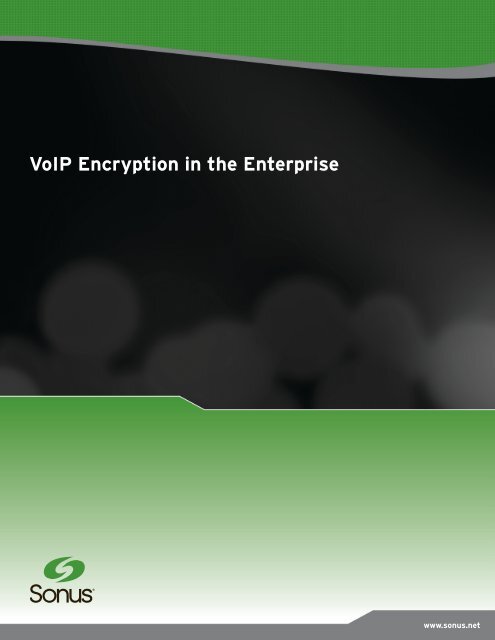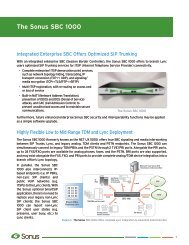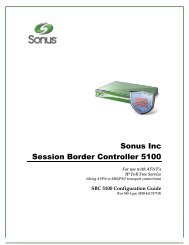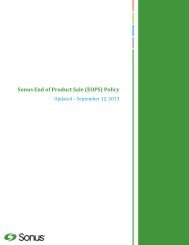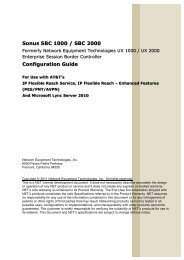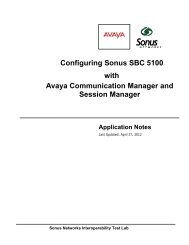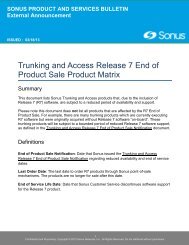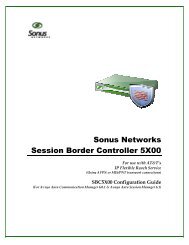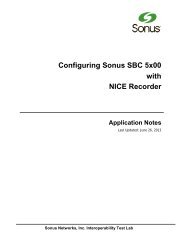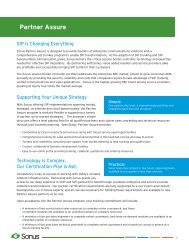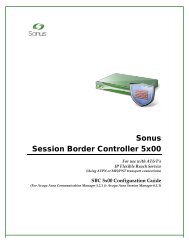VoIP Encryption in the Enterprise - Sonus Networks
VoIP Encryption in the Enterprise - Sonus Networks
VoIP Encryption in the Enterprise - Sonus Networks
You also want an ePaper? Increase the reach of your titles
YUMPU automatically turns print PDFs into web optimized ePapers that Google loves.
Hack<strong>in</strong>g <strong>in</strong>to <strong>VoIP</strong> or UC sessions requires that <strong>the</strong> malicious party <strong>in</strong>tercept signal<strong>in</strong>g and/or media flow<strong>in</strong>g between twoendpo<strong>in</strong>ts at any of several po<strong>in</strong>ts along <strong>the</strong> communications path. The po<strong>in</strong>t of attack may <strong>in</strong>clude:> > UC application servers;> > Call control elements such as PBXs and Automatic Call Distributors (ACDs);> > Session-layer servers and proxies such as session border controllers;> > Transport and network layer elements like routers;> > L<strong>in</strong>k-layer elements <strong>in</strong>clud<strong>in</strong>g E<strong>the</strong>rnet and wireless LANs; or on <strong>the</strong> endpo<strong>in</strong>ts <strong>the</strong>mselves via malware downloads oradm<strong>in</strong>istrator-level remote access.Man-<strong>in</strong>-<strong>the</strong>-middle attacks are ano<strong>the</strong>r threat on IP-based communications, <strong>in</strong> which software <strong>in</strong>jects itself <strong>in</strong>to <strong>the</strong>voice, video, or <strong>in</strong>stant messag<strong>in</strong>g stream between two endpo<strong>in</strong>ts, selectively alter<strong>in</strong>g certa<strong>in</strong> packets so as to be nearlyundetectable to <strong>the</strong> end users. Modify<strong>in</strong>g, disrupt<strong>in</strong>g, or lower<strong>in</strong>g <strong>the</strong> quality of IP communications can have a variety ofadverse effects on <strong>the</strong> enterprise. For example, an attacker can modify or discard critical f<strong>in</strong>ancial transactions, disruptbus<strong>in</strong>ess operations, or reduce <strong>the</strong> quality of customer service.Where Does Real-Time <strong>Encryption</strong> Fit <strong>in</strong> <strong>the</strong> Broader <strong>VoIP</strong> Security Picture?To defend aga<strong>in</strong>st <strong>the</strong> widest possible range of <strong>VoIP</strong>-based attacks, an enterprise <strong>VoIP</strong> security strategy should protect both<strong>the</strong> endpo<strong>in</strong>t and <strong>the</strong> media itself. This can be achieved through a holistic security approach that <strong>in</strong>cludes:> > VPNs to logically separate voice and data traffic on <strong>the</strong> common IP network;> > Border security elements such as session border controllers to provide call admission control and protect aga<strong>in</strong>stDoS attacks;> > Signal<strong>in</strong>g and media encryption of <strong>VoIP</strong> sessions, <strong>in</strong>clud<strong>in</strong>g those sessions stored on voice messag<strong>in</strong>g systems and callrecord<strong>in</strong>g systems.While many enterprises have implemented VPN and border security technologies to protect <strong>the</strong>ir IP-based data networks,<strong>the</strong> encryption of <strong>VoIP</strong> signal<strong>in</strong>g and media is a unique consideration that has grown <strong>in</strong> importance with <strong>the</strong> advent of morepervasive <strong>VoIP</strong>/UC implementations <strong>in</strong> <strong>the</strong> enterprise.SBCs without dedicatedencryption hardware willnormally encrypt trafficat <strong>the</strong> expense of sessionperformance.<strong>Encryption</strong> of <strong>VoIP</strong> Signal<strong>in</strong>g and MediaThe encryption of <strong>VoIP</strong> signal<strong>in</strong>g and media mitigates a number of IP-basedthreats <strong>in</strong>clud<strong>in</strong>g passive monitor<strong>in</strong>g/record<strong>in</strong>g, packet decryption/modification,service/bandwidth <strong>the</strong>ft, endpo<strong>in</strong>t impersonation, denial of service, andescalation of network user privileges. Because signal<strong>in</strong>g and media use differentprotocols with unique properties and constra<strong>in</strong>ts, <strong>VoIP</strong> networks employTransport Layer Security (TLS) and/or IPsec for signal<strong>in</strong>g encryption and SecureRTP (SRTP) for encrypt<strong>in</strong>g RTP media. TLS and IPsec provide bilateral endpo<strong>in</strong>tau<strong>the</strong>ntication and secure transport of signal<strong>in</strong>g <strong>in</strong>formation us<strong>in</strong>g advancedcryptography. SRTP provides encryption (and decryption) of <strong>the</strong> RTP media used<strong>in</strong> real-time IP communications such as <strong>VoIP</strong> and certa<strong>in</strong> UC applications (e.g.,conferenc<strong>in</strong>g and IM).TLS, IPsec, and SRTP encryption enable enterprises to secure <strong>VoIP</strong>communications by perform<strong>in</strong>g three key functions:> > Endpo<strong>in</strong>t au<strong>the</strong>ntication: This supports <strong>the</strong> use of digital signatures (whichmay be proprietary or verified by a trusted third party) and pre-shared,secret-based au<strong>the</strong>ntication to verify <strong>the</strong> identity of session endpo<strong>in</strong>ts;> > Message <strong>in</strong>tegrity: This ensures that media and signal<strong>in</strong>g messages havenot been altered or replayed between endpo<strong>in</strong>ts;> > Privacy: Encrypted messages can only be viewed by authorized endpo<strong>in</strong>ts,mitigat<strong>in</strong>g <strong>in</strong>formation/service <strong>the</strong>ft and satisfy<strong>in</strong>g both regulatory andcorporate requirements for private communications.Ensur<strong>in</strong>g that your<strong>VoIP</strong> security solutionemploys <strong>the</strong> latestencryption/decryptionmethods is vital toensur<strong>in</strong>g broad network/UC <strong>in</strong>teroperability <strong>in</strong><strong>the</strong> future.
The Cost of “No Security”Everyone is familiar with <strong>the</strong> risks posed by attacks on <strong>the</strong> data side of <strong>the</strong> network: stolen credit card numbers,compromised passwords, Denial of Service, f<strong>in</strong>ancial fraud, Social Security number <strong>the</strong>ft, etc. Those same risks apply to <strong>VoIP</strong>communications as well, though <strong>the</strong>y may manifest <strong>the</strong>mselves <strong>in</strong> different ways such as eavesdropp<strong>in</strong>g, Telephony Denial ofService (TDoS) attacks, and ANI spoof<strong>in</strong>g targeted to call centers. Yet <strong>the</strong>se can be equally destructive, consum<strong>in</strong>g valuableresources, driv<strong>in</strong>g down revenue, and damag<strong>in</strong>g brand equity.The most serious consequence of a nonsecure <strong>VoIP</strong> network rema<strong>in</strong>s <strong>the</strong> exposure of confidential <strong>in</strong>formation:> > Private consumer data (e.g., Social Security numbers);> > Sensitive company <strong>in</strong>formation (sales data, market<strong>in</strong>gplans, new product details);> > Cardholder data (e.g., credit or debit card numbers);> > Patient data (e.g., diagnosis and prescription records).An enterprise security breach that discloses confidential <strong>in</strong>formation can result <strong>in</strong> f<strong>in</strong>ancial penalties and o<strong>the</strong>r sanctions. Forexample, a s<strong>in</strong>gle <strong>in</strong>cidence of non-compliance <strong>in</strong> credit card process<strong>in</strong>g can generate multimillion-dollar f<strong>in</strong>es and liability forlosses from fraud and <strong>the</strong>ft. Mandated costs can also <strong>in</strong>clude re-issu<strong>in</strong>g cards, communicat<strong>in</strong>g <strong>the</strong> breach to customers, andsuspension of card-process<strong>in</strong>g rights.Non-compliance with federal and <strong>in</strong>dustry security regulations can cost enterprises millions of dollars <strong>in</strong> f<strong>in</strong>es, compensation,and lost revenue. Here’s a partial list of regulatory measures that govern how enterprises should address <strong>VoIP</strong> security.AGENCY INDUSTRY GOALSRELEVANT <strong>VoIP</strong>/UC ISSUESGramm-Leach-Bliley Act (GLBA)Any company <strong>in</strong>volved <strong>in</strong>f<strong>in</strong>ancial services (bank<strong>in</strong>g,credit, securities, <strong>in</strong>surance, etc.)Privacy for f<strong>in</strong>ancial servicescustomers, <strong>in</strong>clud<strong>in</strong>g <strong>the</strong> securityand confidentiality of customerrecords.Prevent unauthorized <strong>VoIP</strong>packet <strong>in</strong>terception & decryption.Secure <strong>in</strong>ternal wirelessnetworks and communicationsover public wireless networks.Health Insurance Portability andAccountability Act (HIPAA)Any organization that handlesmedical records or o<strong>the</strong>rpersonal health <strong>in</strong>formation.Privacy for healthcare patients:medical records, diagnosis,x-rays, photos, prescriptions, labwork, and test results.Secure authorized <strong>in</strong>ternal &external access to patient data.Sarbanes-Oxley Act (SOX)Public companiesSecurity & audit<strong>in</strong>g of publiccompaniesMa<strong>in</strong>ta<strong>in</strong> <strong>VoIP</strong> usage logs & trackadm<strong>in</strong>istrative changes.Implement strong au<strong>the</strong>nticationpolicies to prevent unauthorizedsystem use.Federal Information SecurityManagement Act (FISMA)Any US federal agency,contractor, or company/organization that uses/operatesan <strong>in</strong>formation system on behalfof a federal agency.IT security for US federalagencies.Mandates implementation ofpolicies & procedures to reduceIT security risks.FISMA requirements for Systemand Information Integrity (SI) for<strong>VoIP</strong>/UC.Implement solutions to remediatesecurity flaws; provide securityalerts & advisories; protectaga<strong>in</strong>st malicious code; detect &prevent network <strong>in</strong>trusions andmalware; ma<strong>in</strong>ta<strong>in</strong> application &<strong>in</strong>formation <strong>in</strong>tegrity.Payment Card Industry DataSecurity Standard (PCI DSS)Any company that issues oraccepts VISA, MasterCard,American Express, D<strong>in</strong>ers Club,or Discover credit or debit cards.Privacy of confidentialcardholder (customer)<strong>in</strong>formation.Protect confidential cardholderdata and sensitive <strong>in</strong>formationshared between employees over<strong>VoIP</strong> calls or UC sessions.Protect sensitive <strong>in</strong>formationstored on voice messag<strong>in</strong>g orcall record<strong>in</strong>g systems.Track and monitor accessto network resources andcardholder data.
Effectively Deploy<strong>in</strong>g <strong>VoIP</strong> <strong>Encryption</strong> <strong>in</strong> <strong>the</strong> <strong>Enterprise</strong>The presence of TLS, IPsec, and SRTP encryption may <strong>in</strong>crease call latency. Therefore, signal<strong>in</strong>g and media encryption mustbe thoughtfully <strong>in</strong>tegrated <strong>in</strong>to <strong>the</strong> IP network traffic flow to prevent added network latency or decreased performance underload. <strong>Enterprise</strong>s must weigh several considerations before <strong>the</strong>y deploy <strong>VoIP</strong> encryption <strong>in</strong> <strong>the</strong>ir network:> > Session Performance —Remember that encryptionrequires additional process<strong>in</strong>gof signal<strong>in</strong>g and media. Extra“hops” to a separate encryptiondevice <strong>in</strong> <strong>the</strong> network or anSBC that performs encryptionfrom <strong>the</strong> ma<strong>in</strong> CPU can addunwanted latency to realtimecommunications orcompromise call-handl<strong>in</strong>gcapacity. Therefore, it’simportant to f<strong>in</strong>d an encryptionsolution that has m<strong>in</strong>imalimpact on session capacityand network performance.While enterprises shouldconsider implement<strong>in</strong>g securitysolutions such as standaloneSession Border Controllers(SBCs), enterprises shouldbe aware that SBCs withoutdedicated encryption hardwarewill normally encrypt trafficat <strong>the</strong> expense of sessionperformance.SBC 9000 SBC 5200Built on GSX9000 platformCentralized rout<strong>in</strong>g via PSXTDM migrat<strong>in</strong>g to IP-PI withmedia transcod<strong>in</strong>gCompell<strong>in</strong>g migration path ofgateway <strong>in</strong>vestmentBuilt on pure IP platformEmbedded or centralizedPSX rout<strong>in</strong>g eng<strong>in</strong>eIP-IP with media transcod<strong>in</strong>gIndustry Lead<strong>in</strong>gPerformance DensilyFIGURE 12. The Next Generation of Border Control> > Multimedia Support — As UC <strong>in</strong>itiatives grow, enterprises will be required to handle a variety of multimedia sessions<strong>in</strong>clud<strong>in</strong>g voice, video, IM, and collaborative applications. To reduce cost and network complexity, enterprises should lookfor an SBC that has robust transcod<strong>in</strong>g capabilities and supports multiple media types.> > <strong>Encryption</strong> Standards — Simply put, some decryption standards are more accepted/effective than o<strong>the</strong>rs. Ensur<strong>in</strong>g thatyour <strong>VoIP</strong> security solution employs <strong>the</strong> latest encryption/decryption methods is vital to ensur<strong>in</strong>g broad network/UC<strong>in</strong>teroperability <strong>in</strong> <strong>the</strong> future.> > Disaster/Failover Recovery —Network equipment failures, fiber cuts, and natural disasters happen despite <strong>the</strong> best precautions. <strong>Enterprise</strong> securitysystems need to be prepared for this reality with a backup/failover plan for all aspects of security <strong>in</strong>clud<strong>in</strong>g <strong>VoIP</strong>/UCsession encryption. This can best be achieved by deploy<strong>in</strong>g SBCs <strong>in</strong> redundant, paired configurations.> > Centralized Policy Management — For <strong>the</strong> reasons cited above as well as human error and operational cost, a centralmanagement console for encryption policies <strong>in</strong> <strong>the</strong> network is both desirable and essential.<strong>Sonus</strong> Session Border Control: Best <strong>in</strong> ClassWhen it comes to <strong>VoIP</strong> network security, enterprises need a solution that protects <strong>the</strong>ir network and customer data withoutcompromis<strong>in</strong>g real-time communications performance. As a leader <strong>in</strong> secure <strong>VoIP</strong> networks, <strong>Sonus</strong> <strong>Networks</strong> has for manyyears offered its customers a high-performance border solution with <strong>the</strong> hybrid TDM/IP <strong>Sonus</strong> SBC 9000 session bordercontroller. The <strong>Sonus</strong> SBC 5200 session border controller is a pure IP appliance that meets <strong>the</strong> cost and performancerequirements of enterprise <strong>VoIP</strong> deployments. The SBC 5200 is built on an IP-optimized platform that delivers plug-and-playfunctionality and high (99.999%) reliability.<strong>Sonus</strong> SBCs feature a unique architectural design that differs from o<strong>the</strong>r SBCs on <strong>the</strong> market today by aggregat<strong>in</strong>g all of <strong>the</strong>session border functionality—security, encryption, transcod<strong>in</strong>g, call rout<strong>in</strong>g, and session management—<strong>in</strong>to a s<strong>in</strong>gle deviceand distribut<strong>in</strong>g those functions to embedded hardware with<strong>in</strong> <strong>the</strong> device. For example, media transcod<strong>in</strong>g on <strong>the</strong> SBC 5200and SBC 9000 is performed on an embedded DSP farm while much of <strong>the</strong> encryption is handled on embedded cryptographichardware, provid<strong>in</strong>g optimal SBC performance dur<strong>in</strong>g real-world workloads, overloads, and attacks.
Because SRTP and IPsec occur lower <strong>in</strong> <strong>the</strong> protocol stack, <strong>Sonus</strong> has elected to perform <strong>the</strong>se tasks on dedicated hardwarewith<strong>in</strong> <strong>the</strong> SBC 5200 and SBC 9000. This provides much better performance dur<strong>in</strong>g heavy encryption workloads than SBCsthat use software for encryption, which can divert process<strong>in</strong>g power from <strong>the</strong> ma<strong>in</strong> CPU.ConclusionAs enterprises shift more of <strong>the</strong>ir critical <strong>in</strong>ternal and external communications to a unified, IP-based voice/data network,<strong>the</strong>y are <strong>in</strong>creas<strong>in</strong>g <strong>the</strong>ir network’s exposure to <strong>VoIP</strong>-based attacks. Meanwhile, <strong>the</strong> cost of not practic<strong>in</strong>g secure <strong>VoIP</strong>communications is ris<strong>in</strong>g <strong>in</strong> <strong>the</strong> form of stricter government and <strong>in</strong>dustry regulations and <strong>the</strong> direct costs of lost confidential<strong>in</strong>formation, lost service, and lost credibility. With <strong>the</strong> trend toward real-time unified communications, <strong>the</strong> requirementsof <strong>VoIP</strong> security will <strong>in</strong>crease exponentially, plac<strong>in</strong>g added importance on solutions that deliver high scalability and highperformance.<strong>Sonus</strong> SBCs provide enterprises with a cost-effective and scalable solution for <strong>VoIP</strong> security and encryption. With a uniquearchitecture that divides security functions among multiple processors on a s<strong>in</strong>gle chassis, <strong>Sonus</strong> SBCs deliver <strong>the</strong> highperformanceencryption and security that enterprises need to navigate <strong>the</strong> future of all-IP communications safely and securely.About <strong>Sonus</strong><strong>Sonus</strong> is a lead<strong>in</strong>g provider of media gateway, centralized call rout<strong>in</strong>g, and session border control solutions for enterprises.<strong>Sonus</strong> solutions enable enterprises to reduce <strong>the</strong>ir recurr<strong>in</strong>g telecom costs, gracefully manage <strong>the</strong> migration from legacyvoice to <strong>VoIP</strong>, and mitigate bus<strong>in</strong>ess cont<strong>in</strong>uity and security threats for critical enterprise voice and contact center<strong>in</strong>frastructure. <strong>Sonus</strong> solutions are deployed throughout <strong>the</strong> world’s largest SIP networks, driv<strong>in</strong>g over 5,854 SIP sessionsevery second.
<strong>Sonus</strong> <strong>Networks</strong> –North American Headquarters4 Technology Park DriveWestford, MA 01886U.S.A.Tel: +1-855-GO-SONUS<strong>Sonus</strong> <strong>Networks</strong> – EMEA Headquarters56 K<strong>in</strong>gston RoadSta<strong>in</strong>es, TW18 4NLUnited K<strong>in</strong>gdomTel: +44 207 643 2219<strong>Sonus</strong> <strong>Networks</strong> – APAC Headquarters1 Fullerton Road #02-01One FullertonS<strong>in</strong>gapore 049213S<strong>in</strong>gaporetel: +65 6832 5589<strong>Sonus</strong> <strong>Networks</strong> – CALA HeadquartersMexico City, Campos Eliseos PolancoAndrés Bello 10, Pisos 6 y 7, Torre ForumCol. Chapultepec Morales, Ciudad de MéxicoMexico City, 11560 MexicoTel: +52 55 36010600The content <strong>in</strong> this document is for <strong>in</strong>formational purposes only and is subject to change by <strong>Sonus</strong> <strong>Networks</strong> without notice. While reasonable efforts have been made <strong>in</strong> <strong>the</strong> preparation of this publicationto assure its accuracy, <strong>Sonus</strong> <strong>Networks</strong> assumes no liability result<strong>in</strong>g from technical or editorial errors or omissions, or for any damages result<strong>in</strong>g from <strong>the</strong> use of this <strong>in</strong>formation. Unless specifically<strong>in</strong>cluded <strong>in</strong> a written agreement with <strong>Sonus</strong> <strong>Networks</strong>, <strong>Sonus</strong> <strong>Networks</strong> has no obligation to develop or deliver any future release or upgrade or any feature, enhancement or function.Copyright © 2012 <strong>Sonus</strong> <strong>Networks</strong>, Inc. All rights reserved. <strong>Sonus</strong> is a registered trademark and SBC 5200 and SBC 9000 are trademarks of <strong>Sonus</strong> <strong>Networks</strong>, Inc. All o<strong>the</strong>r trademarks, service marks,registered trademarks or registered service marks may be <strong>the</strong> property of <strong>the</strong>ir respective owners.Pr<strong>in</strong>ted <strong>in</strong> <strong>the</strong> USA 05/12WP-1125 Rev. B


